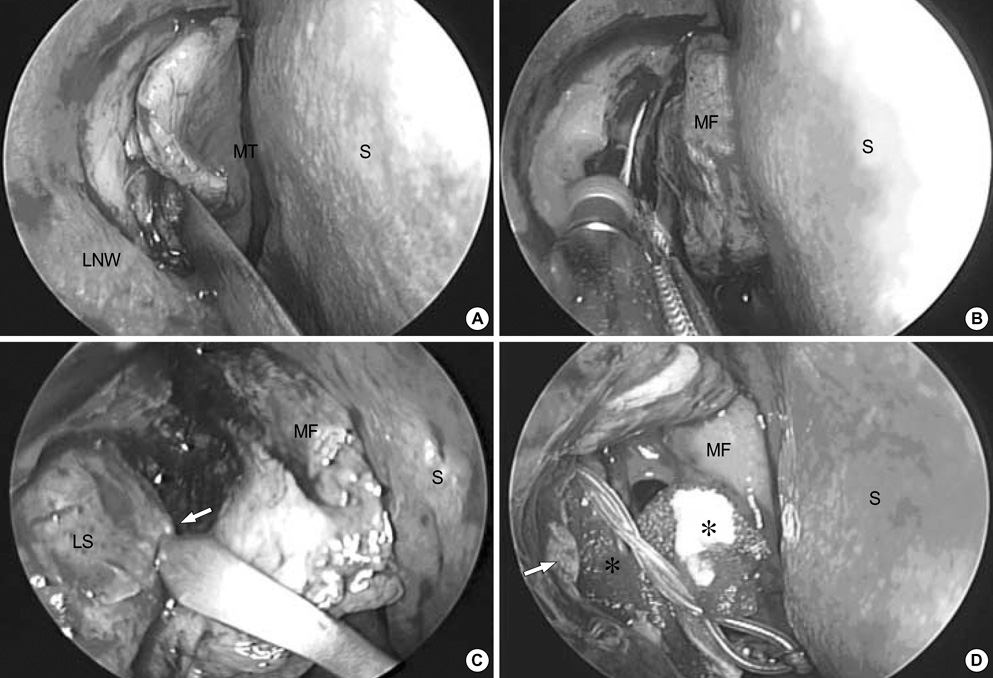J Korean Med Sci.
2006 Aug;21(4):719-723. 10.3346/jkms.2006.21.4.719.
Endoscopic Dacryocystorhinostomy: Creation of a Large Marsupialized Lacrimal Sac
- Affiliations
-
- 1Department of Otorhinolaryngology-Head and Neck Surgery, Seoul National University Boramae Hospital, Seoul, Korea. hrjin@paran.com
- 2Department of Otolaryngology, Chungbuk National University Hospital, Cheongju, Korea.
- 3Department of Ophthalmology, Chungbuk National University Hospital, Cheongju, Korea.
- KMID: 2157827
- DOI: http://doi.org/10.3346/jkms.2006.21.4.719
Abstract
- This retrospective study describes and evaluates the effectiveness of a modified technique of conventional endoscopic dacryocystorhinostomy (DCR) that minimizes the obstruction of a neo-ostium by creating an enlarged marsupialized lacrimal sac using mucosal flaps. Forty-two patients who had undergone 46 endoscopic DCR at a tertiary medical center, from 2002 to 2004, for correction of lacrimal system obstruction were investigated. The surgical technique involves elevation of a nasal mucosal flap, full sac exposure using a power drill, and shaping of the mucosal flap to cover denuded bone and juxtapose exposed sac mucosa. Postoperative symptoms and endoscopic findings of the neo-ostium were evaluated. Mean duration of follow-up was 5.9 months. An eighty-three percent primary success rate was observed, without any serious complications. Obstruction of the neo-ostium with granulation tissue was observed in eight cases, among which six underwent revision with success in all cases. Overall, 44 (96%) of 46 cases experienced surgical successes. Endoscopic DCR, a procedure in which a large marsupialized lacrimal sac is created from mucosal flaps, yields a very satisfactory success rate with straightforward and highly successful revision available for those in whom the primary procedure yields a substandard result.
MeSH Terms
Figure
Cited by 1 articles
-
Results of Endonasal Dacryocystorhinostomy with Lacrimal Sac Flap and Silastic Sheet
Hyun Duk Jang, Sang Soo Kim
J Korean Ophthalmol Soc. 2011;52(12):1391-1398. doi: 10.3341/jkos.2011.52.12.1391.
Reference
-
1. Jones LT. The cure of epiphora due to canalicular disorders, trauma and surgical failures on the lacrimal passages. Trans Am Acad Ophthalmol Otolaryngol. 1962. 66:506.2. McDonough M, Meiring JH. Endoscopic transnasal dacryocystorhinostomy. J Laryngol Otol. 1989. 103:585–587.3. Watkins LM, Janfaza P, Rubin PA. The evolution of endonasal dacryocystorhinostomy. Surv Ophthalmol. 2003. 48:73–84.
Article4. Hartikainen J, Antila J, Varpula M, Puukka P, Seppa H, Grenman R. Prospective randomized comparison of endonasal endoscopic dacryocystorhinostomy and external dacryocystorhinostomy. Laryngoscope. 1998. 108:1861–1866.
Article5. Ben Simon GJ, Joseph J, Lee S, Schwarcz RM, McCann JD, Goldberg RA. External versus endoscopic dacryocystorhinostomy for acquired nasolacrimal duct obstruction in a tertiary referral center. Ophthalmology. 2005. 112:1463–1468.
Article6. Ibrahim HA, Batterbury M, Banhegyi G, McGalliard J. Endonasal laser dacryocystorhinostomy and external dacryocystorhinostomy outcome profile in a general ophthalmic service unit: a comparative retrospective study. Ophthalmic Surg Lasers. 2001. 32:220–227.
Article7. Tsirbas A, Davis G, Wormald PJ. Revision dacryocystorhinostomy: a comparison of endoscopic and external techniques. Am J Rhinol. 2005. 19:322–325.
Article8. Massaro BM, Gonnering RS, Harris GJ. Endonasal laser dacryocystorhinostomy: A new approach to nasolacrimal duct obstruction. Arch Ophthalmol. 1990. 108:1172–1176.9. Metson R, Woog JJ, Puliafito CA. Endoscopic laser dacryocystorhinostomy. Laryngoscope. 1994. 104:269–274.
Article10. Zilelioglu G, Tekeli O, Ugurba SH, Akiner M, Akturk T, Anadolu Y. Results of endoscopic endonasal non-laser dacryocystorhinostomy. Doc Ophthalmol. 2002. 105:57–62.11. Gurler B, San I. Long-term follow-up outcomes of nonlaser intranasal endoscopic dacryocystorhinostomy: how suitable and useful are conventional surgical instruments? Eur J Ophthalmol. 2004. 14:453–460.
Article12. Sham CL, van Hasselt CA. Endoscopic terminal dacryocystorhinostomy. Laryngoscope. 2000. 110:1045–1049.
Article13. Selig YK, Biesman BS, Rebeiz EE. Topical application of mitomycin-C in endoscopic dacryocystorhinostomy. Am J Rhinol. 2000. 14:205–207.
Article14. Park DJ, Kwak MS. The effect of mitomycin-C on the success rate of endoscopic dacryocystorhinostomy. J Korean Ophthalmol Soc. 2000. 41:1674–1679.15. Wormald PJ. Powered endoscopic dacryocystorhinostomy. Laryngoscope. 2002. 112:69–72.
Article16. Tsirbas A, Wormald PJ. Mechanical endonasal dacryocystorhinostomy with mucosal flaps. Br J Ophthalmol. 2003. 87:43–47.
Article17. Massegur H, Trias E, Adema JM. Endoscopic dacryocystorhinostomy: modified technique. Otolaryngol Head Neck Surg. 2004. 130:39–46.
Article18. Ozturk S, Konuk O, Ilgit ET, Unal M, Erdem O. Outcome of patients with nasolacrimal polyurethane stent implantation: do they keep tearing? Ophthal Plast Reconstr Surg. 2004. 20:130–135.19. Unlu HH, Toprak B, Aslan A, Guler C. Comparison of surgical outcomes in primary endoscopic dacryocystorhinostomy with and without silicone intubation. Ann Otol Rhinol Laryngol. 2002. 111:704–709.
Article20. Mortimore S, Banhegy GY, Lancaster JL, Karkanevatos A. Endoscopic dacryocystorhinostomy without silicone stenting. J R Coll Surg Edinb. 1999. 44:371–373.21. Lee TS, Kim SW. The effects of placement of bicanalicular silicone tube and silicone stent on granuloma formation in endoscopic intranasal dacryocystorhinostomy. J Korean Ophthalmol Soc. 1999. 40:16–22.22. Fayet B, Racy E, Assouline M. Complications of standardized endonasal dacryocystorhinostomy with unciformectomy. Ophthalmology. 2004. 111:837–845.
- Full Text Links
- Actions
-
Cited
- CITED
-
- Close
- Share
- Similar articles
-
- Success Rate of Endonasal Dacryocystorhinostomy Based on the Location of the Lacrimal Sac
- Endoscopic Dacryocystorhinostomy for the Treatment of Lacrimal Sac Abscess
- The Role of Dacryocystography in Evaluation of Nasolacrimal Duct Obstruction
- The Correlation between Organisms Cultured from the Lacrimal Sac and Lacrimal Punctum in Dacryocystitis
- Posterior Lacrimal Sac Approach in Endoscopic Dacryocystorhinostomy



